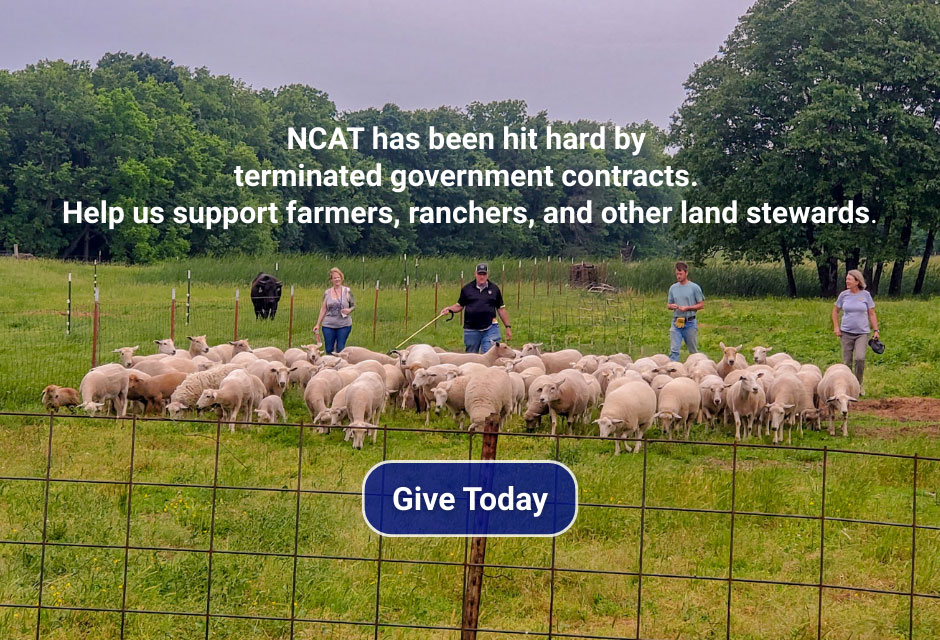Small Steps, Big Vision: Oyster Farming on Long Island’s Great South Bay
 Print This Post
Print This Post
By Lee Rinehart, NCAT Agriculture Specialist
Mike Miezianka and Ray Smith have found a way to beat the average Long Island commute time by almost seventy-five percent. They take a boat. After a fifteen-minute crossing of Great South Bay, their workplace materializes on the horizon: a series of floating cages in discrete rows covering an acre and a half of the estuary. We have arrived at Toasted Oysters Farm, one of twenty-three similar operations scattered across this shallow part of the bay that grows the region’s distinctively flavored Blue Point Oysters.
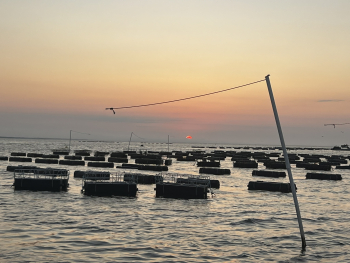
The morning commute. Photo: Lee Rinehart
The journey to Toasted Oysters Farm really began five years earlier, back in 2020. Mike was hanging with Ray in Ray’s backyard, sharing after-work drinks, and the conversation turned speculative, as often happens when long-time friends gather to let the day settle. “I’m going to own an oyster farm,” Ray said out of the blue. I can imagine Mike’s look of curiosity, and Ray’s grin as he sat across from him, sipping his drink. The idea of farming oysters was nothing new to either of them. Ray had been taking a class on oyster farming at the township, but something was different as they sat together that day. That day, there was intention. So, Mike signed up for the next oyster farming class and the die was cast. What would follow over the next five years was a journey that Mike, a Navy veteran and former New York City detective, and Ray, a paramedic, could never have anticipated before that fateful day in Ray’s backyard.
When Mike, Ray, Luke (their summer employee), and I reached the farm the morning they took me out, the sun was balanced on the horizon, bathing the sky salmon as Ray throttled the engine down. The cages, supported by black plastic floats and each holding six oyster bags, bobbled gently in the current, longlines holding them in place, anchors at the end of each row. A converted pontoon boat lay anchored alongside the last row of cages, tethered to a floating pier. Together, they served as boat dock, staging zone, oyster sorting area, and packing house. Ray brought the boat alongside the floating dock and our workday began.
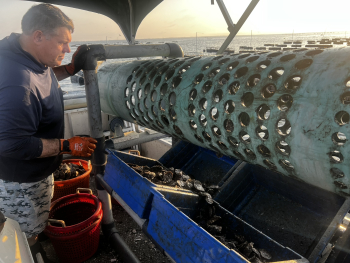
The tumbler Mike and Ray use to sort oysters by size. Photo: Lee Rinehart
Oysters start from seed (yes, seed… small, shelled creatures ranging from one to ten millimeters in diameter) in semirigid mesh bags. In March, Mike and Ray place the bags into floating cages where the oysters will grow rapidly, with an average of eighteen months between planting and harvest. Growth peaks in the summer months when the water temperature is warm and nutrient flows are abundant. Each day during the summer Mike and Ray work the farm, pulling bags from the cages and sorting them in a homemade tumbler, an ingenious device that looks like an oversized potato washer with holes along its surface that allows the oysters to fall into buckets underneath based on their size. After they sort the oysters to size, those that need more growth go back into bags and into the floating cages, and they rinse, bag, and ice the marketable oysters. The process continues all summer. Maintenance tasks such as de-fouling gear, repairing cages, or adjusting longlines also keep them busy throughout the growing season. Then, finally, the fall brings a lull in activity. After their last time sorting, Mike and Ray bag the remaining oysters, lay them on the bay floor to overwinter, and then haul the floating racks back to land, protecting the gear from ice damage.
Once we were tied to the floating dock, Ray and Luke, a college biology student whose work pace never slowed all day, immediately got busy with the tumbler while Mike and I descended the boat’s stern ladder into the seventy-nine-degree water of Great South Bay. There are probably as many ways to access oyster cages as there are oyster farms, and on Mike and Ray’s farm all the oyster handling and maintenance is done by wading out into the bay’s waist-high water. A terrestrial farmer has an advantage in that they can walk easily between rows, drive tractors, or listen to a podcast while working. But an ocean farmer, well, try spending a seven-hour workday walking against an ever-increasing tidal current while manipulating oyster bags into and out of chest-high floating cages. Nothing is lashed down, and everything moves, all the time. And while land farmers may be on constant lookout for snakes and spiders, an attentive oysterman is on vigil against the painful defensive pinches of the blue crab, which finds the aquatic plants that colonize the floating cages to be ideal habitat.
Mike says the demand for seafood is forecasted to increase by 25% from 2024 to 2032, and to cater to consumers’ greater awareness of the benefits of eating locally produced food, Toasted Oysters has adopted a system of traceability through inventory tracking and harvesting software that accurately pinpoints the location of each harvest. They market their oysters to distributors in the Long Island region thanks to the strong relationships they’ve developed with buyers. This year they are expanding into New Jersey, Pennsylvania, and Massachusetts, with a goal to increase their inventory to three million oysters by the end of 2025 to keep up with demand. In addition to distributors, Mike and Ray supply four restaurants, diversifying their distribution channels and enhancing their brand presence among people seeking the briny, savory flavor that distinguishes Blue Point Oysters from other varieties.
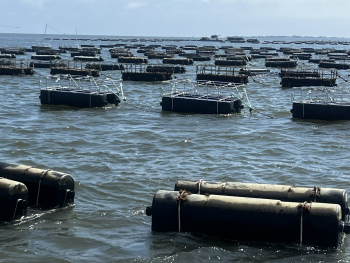
Floating cages at Toasted Oysters Farm. Photo: Lee Rinehart
We’d been on the farm since five-thirty a.m., and as the clock approached noon the tide increased, and walking to and from the cages became a laborious push against an even deeper aqueous surge. As Mike and I handed the bulging bags of oysters up to Luke on the floating dock, we decided it was time to sort the marketable oysters, get them on ice, and call it a day. Mike and I had been talking all day as we worked, about the ecological benefits of filter-feeding shellfish, how heavy rainfall events can temporarily shut down an operation, what to look for in a marketable oyster, and the various practices and communal nature of the close-knit oyster farmer community in the bay. Then our conversation turned toward the pragmatic: I wanted to know his recommendations for beginners.
There are so many moving parts on a shellfish farm: site selection, leasing, regulations, choosing the right equipment, marketing, and acquiring production knowledge. When Mike started out, before he even had a lease, he volunteered on oyster farms to learn the craft. “Farmers are always looking for assistance,” Mike said. Getting out and working on farms acquaints you with the rigors of a normal workday. You get firsthand knowledge of systems and techniques – like which kind of cage system to use depending on water depth, how to install anchors and longlines, what to do about biofouling on cages and cormorants and gulls pooping on your gear.
If you catch the shellfish farming bug, then it’s time to research the available aquaculture lease sites and regulations in your area. “On Long Island,” Mike explained, “several entities manage different regions, each with its own specific rules and regulations, in addition to state regulations.” This is one of the benefits of volunteering on farms. You forge a relationship with an established farmer (who may end up being your neighbor) and you can get firsthand information on leasing and regulations.
Volunteering is essential for learning the trade. As Mike noted, “In oyster farming, the motto is: ‘More flow, more grow, more dough.’” Good water flow is essential for delivering nutrients to your oysters and is the principal consideration in site selection. And finally, Mike recommends you “consider how the farming technique aligns with your current physical abilities. Farming in deeper water requires a larger boat and additional equipment. Conversely, in shallow water, you may need to physically roll cages for anti-fouling measures and navigate walking in tidal currents.”
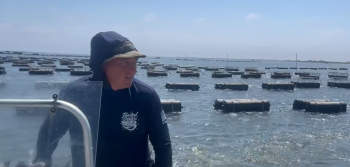
Mike steers the boat away from the oyster farm at the end of the day. Photo: Lee Rinehart
Mike and Ray are proving that small-scale oyster farming can be a viable business, as they are at a point now where they are scaling to a level that will provide a sustainable income. For those who would begin the journey to having their own oyster farm, or any kind of farm for that matter, Mike’s words are salient: “Begin with small steps and maintain a big vision.”
Related Resources
ATTRA Podcast: Farming Oysters with Mike Miezianka
Ocean Farming: a Conversation with Bren Smith
Further Resources
Toasted Oysters – Authentic Blue Point Oysters
Cultivating the Eastern Oyster, Crassostrea virginica
Report: State by State Summary of Shellfish Aquaculture Leasing/Permitting Requirements (2021)

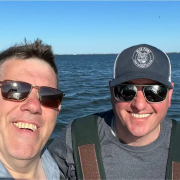
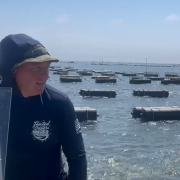
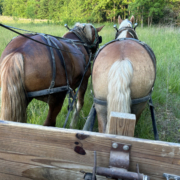
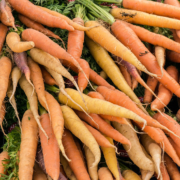 USDA Photo by Lance Cheung.
USDA Photo by Lance Cheung.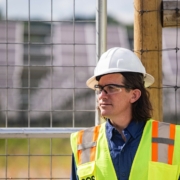
 Dhanush Udayashankara Jamadgni, NC State University
Dhanush Udayashankara Jamadgni, NC State University RAFI-USA
RAFI-USA